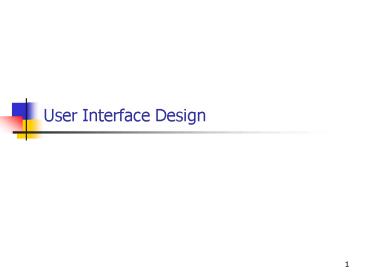User Interface Design - PowerPoint PPT Presentation
1 / 22
Title:
User Interface Design
Description:
User interfaces should be designed to match the skills, experience and ... rejects rather than accepts a system. ... American Institute of Graphic Arts www.aiga.org ... – PowerPoint PPT presentation
Number of Views:47
Avg rating:3.0/5.0
Title: User Interface Design
1
User Interface Design
2
The user interface
- User interfaces should be designed to match the
skills, experience and expectations of its
anticipated users. - System users often judge a system by its
interface rather than its functionality. - A poorly designed interface can cause a user to
make catastrophic errors. - Poor user interface design is the reason why so
many software systems are never used.
3
Human factors in interface design
- Limited short-term memory
- People can instantaneously remember about 7 items
of information. If you present more than this,
they are more liable to make mistakes. - People make mistakes
- When people make mistakes and systems go wrong,
inappropriate alarms and messages can increase
stress and hence the likelihood of more mistakes. - People are different
- People have a wide range of physical
capabilities. Designers should not just design
for their own capabilities. - People have different interaction preferences
- Some like pictures, some like text.
4
User interface design principles
5
Design issues in UIs
- Two problems must be addressed in interactive
systems design - How should information from the user be provided
to the computer system? - How should information from the computer system
be presented to the user? - User interaction and information presentation may
be integrated through a coherent framework such
as a user interface metaphor.
6
Interaction styles
7
Information presentation
- Information presentation is concerned with
presenting system information to system users. - The information may be presented directly (e.g.
text in a word processor) or may be transformed
in some way for presentation (e.g. in some
graphical form).
8
Information display factors
- Is the user interested in precise information or
data relationships? - How quickly do information values change? Must
the change be indicated immediately? - Must the user take some action in response to a
change? - Is there a direct manipulation interface?
- Is the information textual or numeric? Are
relative values important?
9
Alternative information presentations
10
Analogue or digital presentation?
- Digital presentation
- Compact - takes up little screen space
- Precise values can be communicated.
- Analogue presentation
- Easier to get an 'at a glance' impression of a
value - Possible to show relative values
- Easier to see exceptional data values.
11
Presentation methods
12
Displaying relative values
13
Colour displays
- Colour adds an extra dimension to an interface
and can help the user understand complex
information structures. - Colour can be used to highlight exceptional
events. - Common mistakes in the use of colour in
interface design include - The use of colour to communicate meaning
- The over-use of colour in the display.
14
Colour use guidelines
- Limit the number of colours used and be
conservative in their use. - Use colour change to show a change in system
status. - Use colour coding to support the task that users
are trying to perform. - Use colour coding in a thoughtful and consistent
way. - Be careful about colour pairings.
15
Error messages
- Error message design is critically important.
Poor error messages can mean that a user
rejects rather than accepts a system. - Messages should be polite, concise, consistent
and constructive. - The background and experience of users should be
the determining factor in message design.
16
Design factors in message wording
17
User error
- Assume that a nurse misspells the name of a
patient whose records he is trying to retrieve.
18
Good and bad message design
19
User interface evaluation
- Some evaluation of a user interface design
should be carried out to assess its suitability. - Full scale evaluation is very expensive and
impractical for most systems. - Ideally, an interface should be evaluated against
a usability specification. However, it is rare
for such specifications to be produced.
20
Usability attributes
21
Simple evaluation techniques
- Questionnaires for user feedback.
- Video recording of system use and subsequent tape
evaluation. - Instrumentation of code to collect information
about facility use and user errors. - The provision of code in the software to collect
on-line user feedback.
22
Useful resources on UI design
- American Institute of Graphic Arts www.aiga.org
- HCI (Human Computer Interaction) Institute at
Carnegie Mellon www.hcii.cs.cmu.edu - Interaction-Design.org www.interaction-design.org/
encyclopedia - Web pages that suck www.webpagesthatsuck.com































